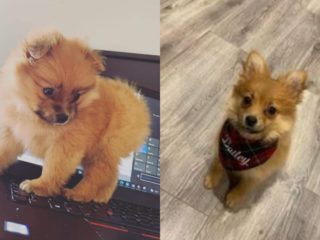If you have a Cocker Spaniel, you already know they are some of the most loyal and friendly companions. Cocker Spaniels are known for their playful personalities and their adorable look! While Cocker Spaniels come in a range of colors, some owners often wonder why their Cocker Spaniel has curly or wavy hair, is this normal?
Cocker Spaniels generally have some curl or wave to their hair. This is most prominent in the curly hair on their ears. English and American Cocker Spaniels will have a different amount of curl in their hair depending on the dog’s genetics, health, and how it is groomed.
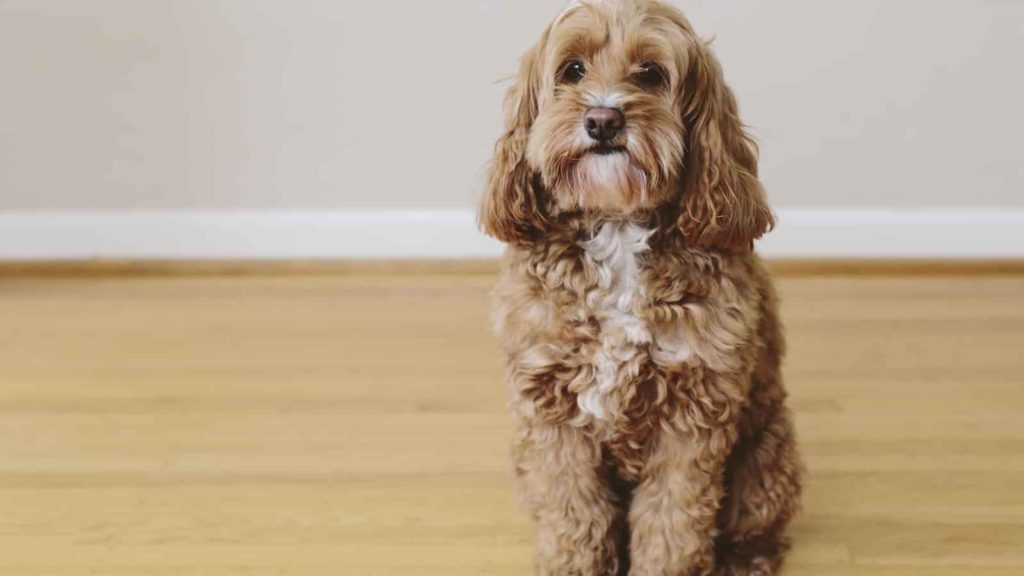
Whether your Cocker Spaniel has curly hair or not, they are guaranteed to be adorable no matter what! If you are interested in knowing more about why your Cocker Spaniel has curly or wavy fur and what it means, keep reading to find out more!
Cocker Spaniel puppy curly hair
Like a lot of other dog breeds, a Cocker Spaniel puppy will eventually grow into its body size and fur type. When they are a puppy, it is oftentimes hard to tell what the fur will look like until the puppy is older.
Cocker Spaniel puppies are born with soft, straight, or wavy hair that can eventually become more course, and curly or wavy as they grow older! Cocker puppies will go through a shedding phase where they will lose their fine fuzzy hair and grow a more course thick adult coat.
Typically, you can start to see what type of fur your pup will have by the time they are 3 months old. By 1 ½ years of age, a Cocker Spaniels adult coat should be fully grown in. This newly grown coat will typically be the coat/fur type they will have for the rest of their lives!
The process your puppy goes through to change its coat from its puppy fur to its adult fur is usually gradual for most dogs. Some dogs however that go through this phase more quickly may look fairly scruffy and strange as they are transitioning.
Disclaimer: This post may contain affiliate links. We only recommend high-quality products that are used and recommended by real owners. If you use these links to buy something we earn a small commission.
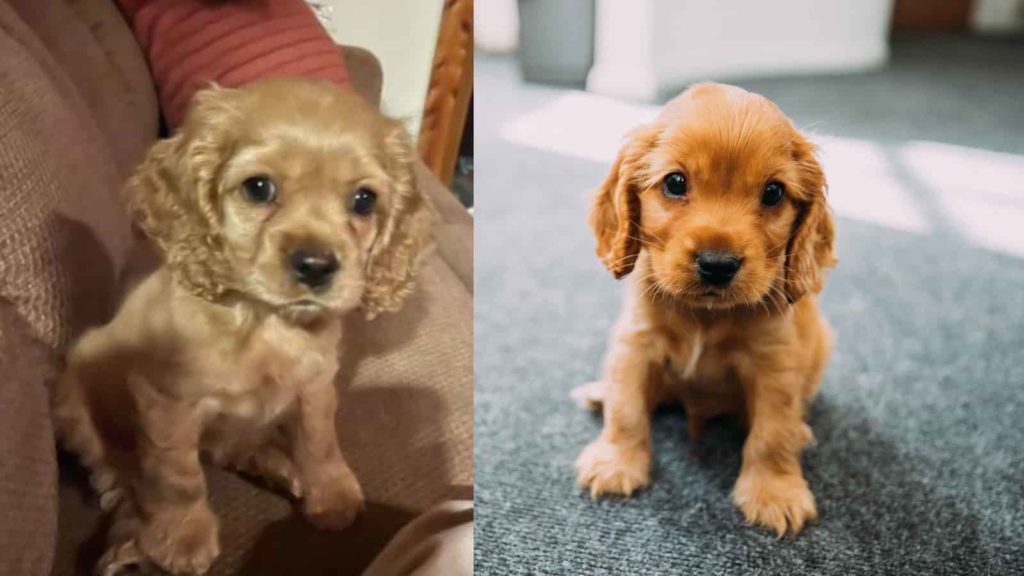
True for both English and American Cocker Spaniels when they shed their puppy coat it can look a bit patchy and uneven. Sometimes the adult coat will grow faster on certain parts of its body than others.
A Cocker Spaniel’s tail, for example, generally begins to gain its fluff by the time it is around 6–7 months old, becoming even fluffier and feathered as it grows older!
Some owners wonder if they should trim their puppy’s coat to encourage growth for their adult coat. There is really no need to do this. In fact, shaving or cutting your dog’s hair may do some damage to their coat in the long run.
Tip: You can encourage the puppy coat to come out by threading an elastic band through the teeth of a comb. If the puppy coat is ready to come out, the band will give you more grip on the hair. It should come out fairly easily. If it doesn’t then it’s not ready yet.
Many groomers will also offer a service called hand stripping. This is where they will remove the dead coat hair by hand instead of clipping or cutting. This helps the hair to have a more tidy and healthy look to it than if it were cut with scissors.
What type of fur do Cocker Spaniels have?
When looking at a Cocker Spaniel, some people might not realize how much fur they have until they pet them and feel for themselves!
Cocker Spaniels have a double coat consisting of a short undercoat designed to keep them warm, and a course (sometimes curly or wavy) overcoat which works great to repel water from the fur!
Cocker Spaniels will normally have feathery hair on certain parts of their bodies, typically on the top of their head, their front legs, chest, back, and tail areas.
This dog breed is known for its silky, shiny coat, this is oftentimes caused by the natural oils that are in the fur. While their fur does contain natural oils, your dog should not have an excessive amount of oil in their fur like some other breeds tend to have.
If your dog’s fur is overly oily or smelly, it is best to visit a vet to find out if there may be an underlying health condition that your dog is experiencing. There can be many ways to rid a dog’s fur from excessive oil including certain shampoos or diet changes.
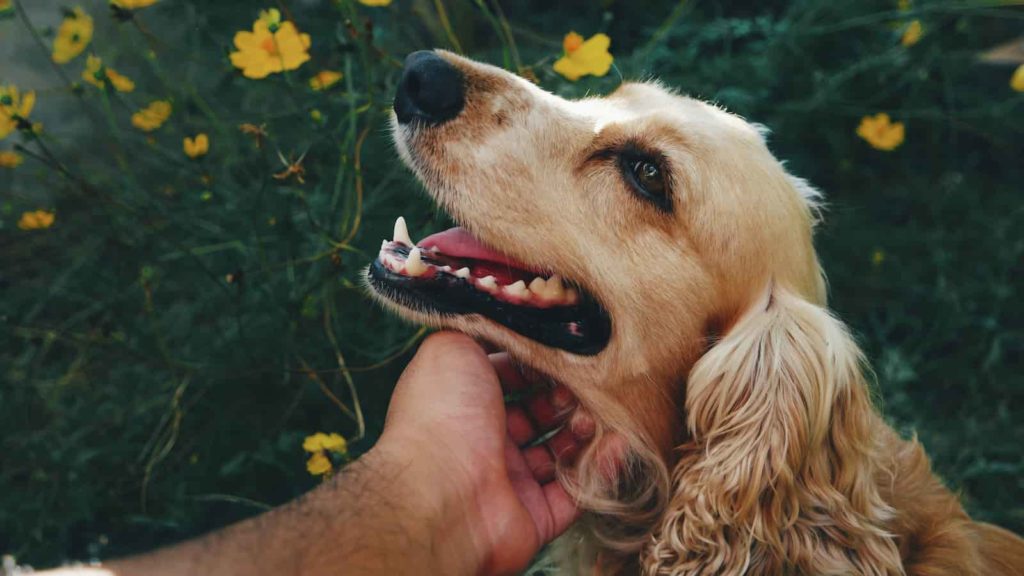
A lot of people who are interested in getting a Cocker Spaniel are often curious about how much they shed, this is often a concern for people who are interested in other dog breeds as well!
Typically, Cocker Spaniels shed twice per year, but they can also shed a significant amount throughout the entire year, this is something to take into consideration when getting a Cocker Spaniel, especially if you or your family has allergies.
Note: Cocker Spaniels are not hypoallergenic! Learn more about Cocker Spaniel shedding here.
Why does my Cocker Spaniel have curly hair?
Many aspects can influence whether or not a Cocker Spaniel will have straight, wavy, or curly hair.
Several main reasons why Cocker Spaniels’ fur texture can become curly or wavy include genetics, overall health, and bloodline.
Genetics is the biggest determiner of whether or not your Cocker Spaniel will have curly or wavy hair. This factor forces their fur to be double-coated. Having this feature is great for repelling water and causes the fur not to become waterlogged.
Here are several reasons why a Cocker Spaniel will develop this fur type:
- Gender
- Skin condition
- Neutered or spayed
- Nutrition
- Grooming
Cocker Spaniels with curly hair are very different from other dogs with curly hair such as Poodles, Labradoodles, or Bichon Frise. Cocker Spaniels will typically only have curly or wavy fur on certain parts of their bodies, specifically the tops of their heads, their long ears, their legs, and around their tails.
A Cocker Spaniel’s fur can also become curly from a lack of coat growth. If they are fed too little or too much, their fur may stop growing as quickly which will then cause the fur to become wavy or curly.
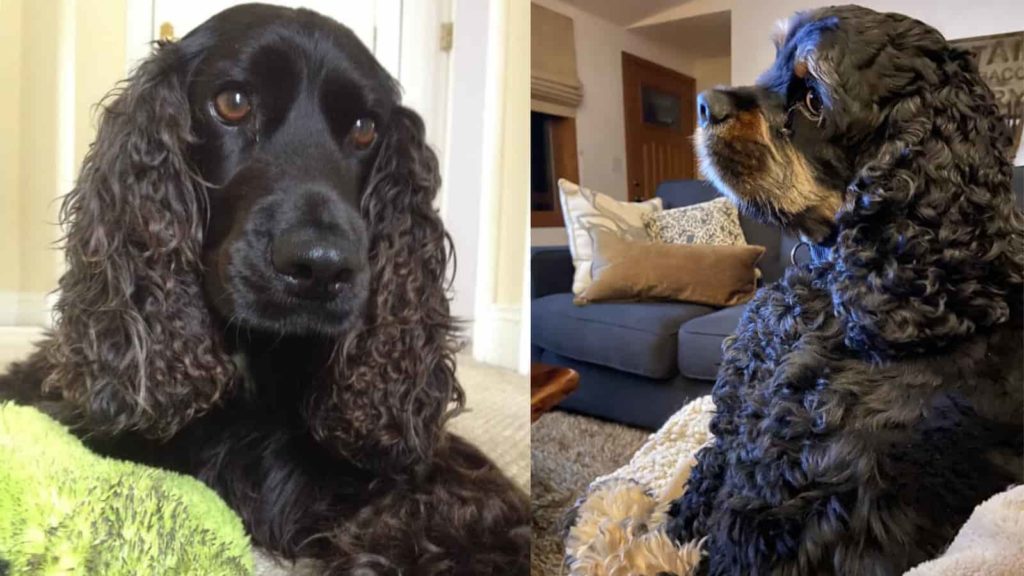
Do all purebred Cocker Spaniels have curly hair?
A lot of dog owners are aware that a non-purebred dog may have different characteristics than a purebred. This is true for Cocker Spaniels too!
Purebred Cocker Spaniels typically have slightly wavy to curly hair, especially if they have longer hair. Their fur will wave or curl up around certain areas of the body such as the back, tail, or ears.
Purebred adult Cocker Spaniels typically have straight hair on their face and backs. Oftentimes in the dense fur of the rest of their bodies, especially their ears, they may develop small masses of wavy hair that is sometimes even tight and curly.
For Cocker Spaniel show dogs the AKC is very particular about the amount of curl allowed. They state “Excessive coat or curly or cottony textured coat shall be severely penalized. The use of electric clippers on the back coat is not desirable. Trimming to enhance the dog’s true lines should be done to appear as natural as possible.”
If your Cocker Spaniel has mostly flat, straight hair with no wave whatsoever as an adult, likely, your dog is not a purebred Cocker Spaniel!
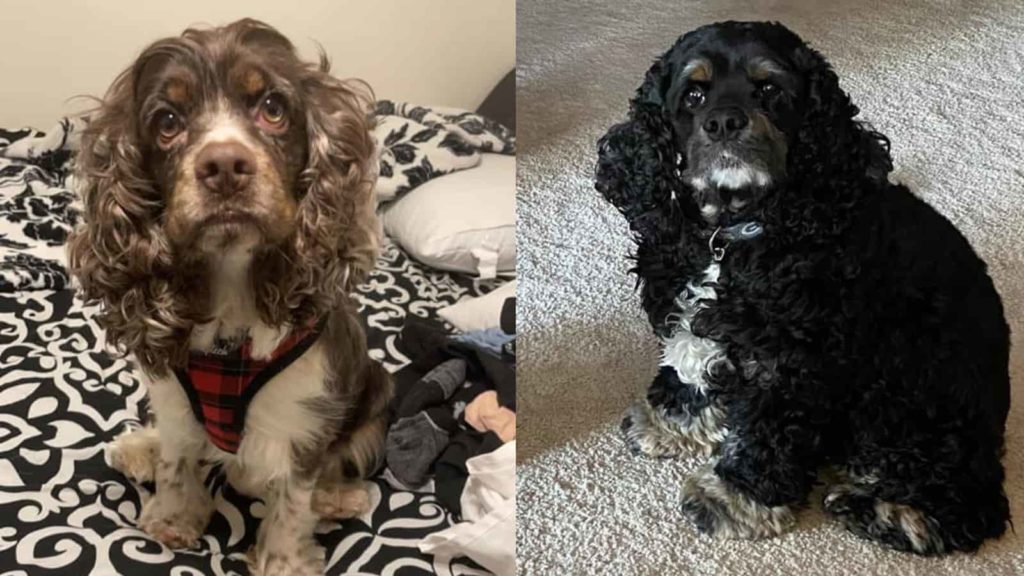
Why is the fur on Cocker Spaniel’s heads and ears so curly?
Genetics is the main reason why English and American Cockers have such curly hair on their ears, head, and other parts of their bodies. There are specific genes that are responsible for triggering the growth of curly hair.
These curly hair genes are dominant, meaning that if your dog has even one of the genes they are likely to show the characteristic of curly or wavy hair.
Can I straighten my Cocker Spaniel’s hair?
In most cases, if your adult Cocker Spaniel has curly hair it is likely to stay that way for its life. It may change slightly over time, but there isn’t a lot that you can do to get it straight. There are a few things however that have helped owners get a bit of a smoother look.
- Blow-dry your dog’s hair after bathing or swimming (Be sure to use a pet blow dryer, a regular blow dryer will be too hot)
- Use a slicker brush
- Use a high-quality conditioner when bathing
- Embrace the waves and curls
Why is my Cocker Spaniel’s hair getting wavy?
If your Cocker Spaniel has always had curly or wavy hair, this is probably caused by genetics and is no problem that you should worry about! Although, It is often a shock to some Cocker Spaniel owners when their dog’s fur suddenly becomes curly or wavy after never being that texture before.
If your dog suddenly begins to develop curly or wavy fur, there could be an issue with their coat such as fur loss or even something more serious such as an underlying health condition.
Keep in mind, however, that like humans, dogs can experience a change in hair growth and texture during different stages of their lives. It is normal to notice a gradual change in your dog’s hair texture and growth during certain phases of their lives, but if the change is very abrupt, you may want to have their health checked!
Like humans, dogs experience different hair phases during their lives, here are the three phases of hair growth in dogs:
1. Anagen Phase — Active growth of hair
2. Catagen Phase — Phase where the hair stops growing
3. Telogen Phase — Resting phase, no new hair grows, shedding begins
It is important to keep watch on your Cocker Spaniel’s fur to ensure there are no sudden changes in the amount of fur your dog has, or if its texture has changed significantly.
If you notice your Cocker Spaniel losing a lot of hair, there are several reasons for this including underlying health issues or even common problems such as stress and anxiety.
Several health problems can cause a Cocker Spaniel’s hair to thin, or fall out, here are a few that are common:
- Hypothyroidism
- Lymes Disease, or tick, mite, and parasite bites in general
- Skin issues/irritation (Dry skin, allergies, eczema, mange, etc.)
- Hormones
Thankfully, there are many options a veterinarian can provide that will get your dog to better health in no time! A lot of these health issues require medications including antibiotics, allergy medicines, creams/ointments, and medicated shampoos among many others!
TIP: If you notice your Cocker Spaniels fur has suddenly become curly or wavy, or your pup is losing hair or pulling it out, it is best to take them to the vet to check up on their health!
Improper grooming can also be a key factor in a Cocker Spaniel’s hair becoming wavy or curly. If there is a buildup of oils from a lack of bathing or brushing, a Cocker Spaniel’s fur is likely to become wavy.
Note: If a Cocker Spaniel is not being groomed properly it can also become matted, this can become an issue if left for a long time.
A change in hair texture is also common if your dog has lost fur or has had to have a section of fur shaved (perhaps for a medical procedure). Like humans, if a dog’s hair falls out or has been shaved when it grows back it could take on a completely different texture.
Many owners have observed that shaving a cocker’s coat will often cause it to grow back very thick and wooly. This is why some owners are very cautious about shaving their dogs and become nervous if their dog has to be shaved for any reason.
Note: It is more likely for double-coated dog fur to grow back in a different texture than it is for a single-coated dog because a double-coat can be easily damaged, this is why Cocker Spaniels are not usually completely shaved.
Learn more in this article: Shaving Your Cocker Spaniel (Pictures & FAQ)
Not only can shaving a Cocker Spaniel affect their fur type but there are also several other reasons why a dog owner should be cautious about shaving or cutting their pup too short. The dog could develop issues such as sunburn, insulation problems, or even skin infections.
How do I maintain my Cocker Spaniel’s fur?
Cocker Spaniels have some of the best-looking fur of all the dog breeds, this is why Cocker Spaniel owners tend to want to keep their dogs fur looking the best that it can be!
There are many different ways to keep a Cocker Spaniel’s fur looking healthy, shiny, and overall great! Some ways to do this include proper grooming, a balanced diet/nutrition, and supplements!
Not only will a good, balanced diet keep the fur looking nice and healthy, but it can also help with your dog’s skin, shedding levels, and overall health.
Tip: One specific supplement that is great for Cocker Spaniels are Omega 3’s!
Regularly grooming a Cocker Spaniel can also keep their fur in great condition! It is recommended to brush a Cocker Spaniel at least once a week and to bathe them every 6–8 weeks depending on how dirty they get and the length of their hair.
One of the most important parts of a Cocker Spaniel’s body that should be groomed is its tail!
Tip: To learn more about grooming the tail specifically, and how to give your Cocker Spaniel the popular “fan” tail, check out this article: Everything to Know About a Cocker Spaniel Tail (With Pictures and Tips)
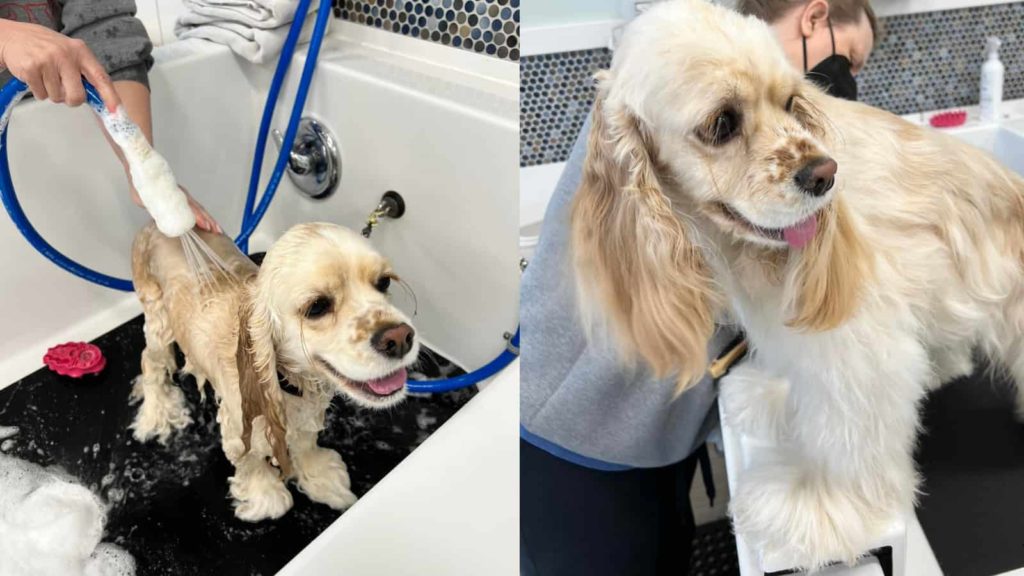
How do I bathe a curly-haired Cocker Spaniel?
When it comes to grooming and bathing a curly/wavy-haired Cocker Spaniel, the steps are very similar to when you are bathing a straight-haired Cocker Spaniel.
When bathing a curly/wavy-haired Cocker Spaniel, it is important to be a little more cautious not to scrub too hard because it will be easier to cause tangles and mats in the curly, wet fur.
There are several important steps to take when bathing your Cocker Spaniel to ensure that their fur comes out looking great after their bath, here are a few key things to consider:
- Rub over the dry fur first with a wet hand to remove any loose or dead hair.
- Use a shampoo that will not irritate your dog and that helps in maintaining oil levels.
- Be sure to use a conditioner, especially if your pup has curly fur!
- Dry your dog with an absorbent towel. Double-coated, and especially double-coated curly-haired dogs hold more moisture in their fur than other dogs!
TIP: Using a wide-tooth comb, or a steel comb on Cocker Spaniels is best since their fur is double-coated, this helps prevent tangles and mats, while also getting rid of loose hair, dirt, and dead skin!
While we strive to give the most accurate and helpful information about your pet’s health that we can, this article is meant to be informational only and not medical advice. Never disregard, avoid or delay in obtaining medical advice from your veterinarian or other qualified veterinary health care provider regardless of what you have read on this site or elsewhere.


